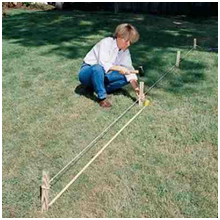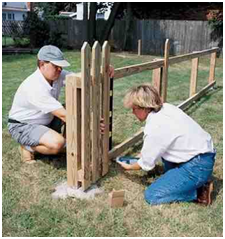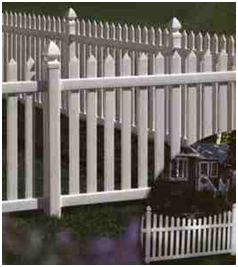DIY (Do It Yourself) Guide – How to Build a Picket Fence
Add Charm, Safety And Privacy for Your Home By Building A Picket Fence
Nothing is more treasured in the home environment than the feeling of security and privacy. Some fences can totally seclude a home from the outside environment; large walls blocking even any site inside the yard. A picket fence is the type of enclosure that does not necessarily intimidate persons as if a big warning sign saying “KEEP OUT” neither does it totally invites persons. It is somewhat in between showing a desire for privacy of the occupants without totally being uninviting.
The picket fence is the type you would very much find in a country home where most neighbours know each other but they are also very stylish on various estate homes or for defining the perimeters of neighbouring blocks. Picket fences are a set of individual boards put together but having a space in between. The majorities are made of wood; cedar wood is often used being naturally resistant to rot and insects. Pine lumber and vinyl are other materials often used in the making of picket fences.
Picket fences are also quite nice and can be found in many different styles which mostly depend on how the top of the fence is made. You therefore have the traditional gothic style, the French gothic style and the French Gothic pointed picket. Building a picket fence is quite an easy DIY job but most be planned accordingly for satisfactory results. Before doing anything like many home improvements, you must know whether it is permitted in your neighbourhood to build such a fence.
Some picket fence can be bought with all the essential parts ready made and only require that you place them accordingly in the desired trajectory to depict the fence. In other circumstance, you can build the entire picket fence from scratch. The choice of fence that you choose can be of personal taste but like many landscaping features, you may have elements in your front yard like for instance a wooden porch that will match with the fence.
Steps for Building a Picket Fence

Follow the total contour of the perimeter placing stakes that outline the whole fence. Where each stake is located will be placed a post. At each location where you have placed a stake which should be 2 meters apart from the end point, dig a hole. Make each holes deep about 1/3 the length of the post.
Place each post into the hole and arrange the post so that it is set in the correct direction (meaning it should be able to link with the adjacent post on a flat surface) set the first post to the desired height. Use a leveler and make certain that the post is leveled in the vertical direction.
Back fill half full the hole with gravel or soil and make certain that the post sits tight in the hole.
On the adjacent post also place a post into the hole making certain that it is placed correctly as noted earlier. Slowly fill the hole half full with sand or gravel. Make certain that the post is leveled both vertically and horizontally with the previous post that you had anchored.

Add some concrete in each holes tamping down accordingly. Leave the concrete to solidify for at least two days. Place on the top and the bottom fence rails. Cut the rails to measure such that it starts from the end post and meets the other rail at the center of the adjacent post. Run the rail all around so that they connect the top and the bottom with each post
Place each pickets according on the rails a few cm apart from each other all along the length of the fence. The rails as well as the pickets should be nailed into place. Make certain that the opening left is of a dimension to accommodate a door of your choosing. Doors can be obtained in different styles. Some may be just a single door; others may be a double door. The dimensions also vary.
Your new picket fence may require a paint job after it is all complete.
Vinyl fence

Beside the fact that vinyl pickets are bought from the manufacturer in sections that consist of the post and the pickets already put together, fixing an vinyl fence is much in the same manner as that of wood.
Start by marking each place where each posts are going to be by placing a stake. Measure the length from one post to the next accordingly and place stakes on the ground. At the locations where the stakes have been placed, dig holes at least 1/3 the length of the post. Have the assistance of someone who can hold one post from one end and the other post held by another person and placed into the holes. Fill the holes with gravels making certain that the whole length of the post is leveled. Place concrete to solidify and fix firmly the post into place. Repeat the procedure by adding each part and connecting accordingly as indicated on the manufacturer’s instruction manual. The vinyl can also be painted to a desired colour according to your preference.
Landscaping by adding a picket fence to your home not only helps enhance the overall appeal of the house but it is a subtle method of seeking privacy without totally covering the whole house with high walls and high fences. It is the perfect solution to not make the house feel confined obtains privacy while offering style and character to the design of the house.
Online Garden Design offering unique landscape designs. Professional landscape designers – Landscape design packages and do it yourself landscape guides. Landscape designs/garden plans for garden makeovers, renovations or landscaping plans for new house builds. Online Garden Designs Australia wide including Sydney, Melbourne, Brisbane, Perth, Adelaide, Canberra, Darwin, Hobart
